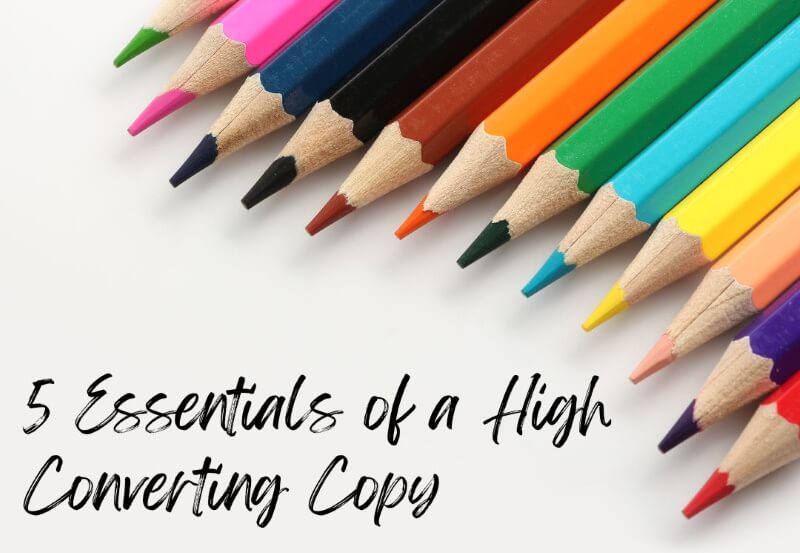5 Essentials of a High Converting Copy

If you want copy that converts, you need to understand these 5 basic essentials of good copywriting.
Good – nay, great copywriting has to have a certain set of standards. By following those standards, you can ensure that your copy has a fighting chance to make your business (or your client’s business) money, and lots of it.
1. Perfect Grammar & Spelling
High converting copy has perfect grammar and spelling.
When a visitor stumbles across your website’s copy, they should look at it and think one word: professional. I want to do business with this company.
If you don’t look professional, you’re pretty much guaranteeing zero new customers for yourself.
One of the big things about looking professional to your audience is having perfect grammar and spelling. A single typo or grammatical error can easily throw off the balance of your copy and decrease the visitor’s perception of your business.
The solution: check each word you write in your copy with meticulous precision. No mistake should escape your notice.
Of course, in certain situations for certain products, a misspelled word or a grammatical error can actually serve to enhance your copy – in those cases, feel free to use poetic license.
2. Audience Targeting

Good copywriting is targeted to a specific audience.
If you’re just writing willy nilly with no real focus in mind as to whom you’re writing the copy for, that again equals zero customers.
You can’t not target the right audience and expect to generate tons of cash with your product.
The solution: use your ideal buyer profile to find out how and in what ways you can target your audience in your copy.
Sometimes, targeting a specific audience can mean using a different dialect of the English language (U.K. English instead of U.S. English, for instance). It could also mean using or not using certain colloquial phrases and/or euphemisms.
Everything you write should consider your target audience.
3. A Good Design
High converting copy is visually appealing.
Often, this can be the most expensive part of the actual copy. However, at the same time, it can also be the most vital aspect, since the quality of your copy’s design can literally make or break your product.
A bad design will repel visitors right from the first moment they get onto your website.
A good design, on the other hand, will suck them in and make sure they pay attention to every word.
The solution: either create a visually appealing design for your copy, or, if graphic design isn’t within your skill set, get one created.
A good design doesn’t always mean a modern one with the latest trends. A simple, old-school design that focuses on what’s important – the content – can work just as well.
4. Relevant Images
High converting copy has highly relevant images in strategic places.
You’ve heard it before, and now you’re hearing it again.
A picture speaks a thousand words. In your copywriting, pictures are priceless.
Here’s the problem, though: most copywriters actually do put pictures in their copy. The issue, however, is that they don’t use the right ones.
An irrelevant image can actually backfire on your copy: instead of exciting your visitors and making them want to purchase the product, you could instead be turning them off.
The solution: use only images that fit your copy to the T. Also, don’t be afraid to pull out your wallet and spend a few bucks on them when the need arises.
Something else that’s almost as important as the image itself is its location. You need to be strategically placing the image specifically where it can have maximum impact.
5. A Solid Product

High converting copy is backed up by a solid, high quality product.
No matter how persuasive your copy is, if your product remains a crappy one, you won’t sell any of it.
The amount of money you spent on the design won’t matter.
The amount of money you spent on a freelance copywriter won’t matter.
The number, relevancy, and locations of the images you used won’t matter.
If your product is low quality, there’s nothing your copy can do to make it sell.
Sure, you might get a few sales here and there from people who haven’t yet heard of your product’s discrepancies from their friends or from the online community.
But you’ll never be able to bring in a steady stream of sales and rise to the top of your industry.
The solution: before even getting started on your copy, make sure your product is nothing short of amazing.
Get people to test-drive your product and find existing. Fix the flaws. Then get more people to test-drive the product. Fix more flaws. Repeat until the number of problems people are noticing is almost at zero.
Do you make sure to have all these essentials in your pieces of copy? Which of these 5 do you personally think is most important? Let us know in the comments below!

Comments (0)